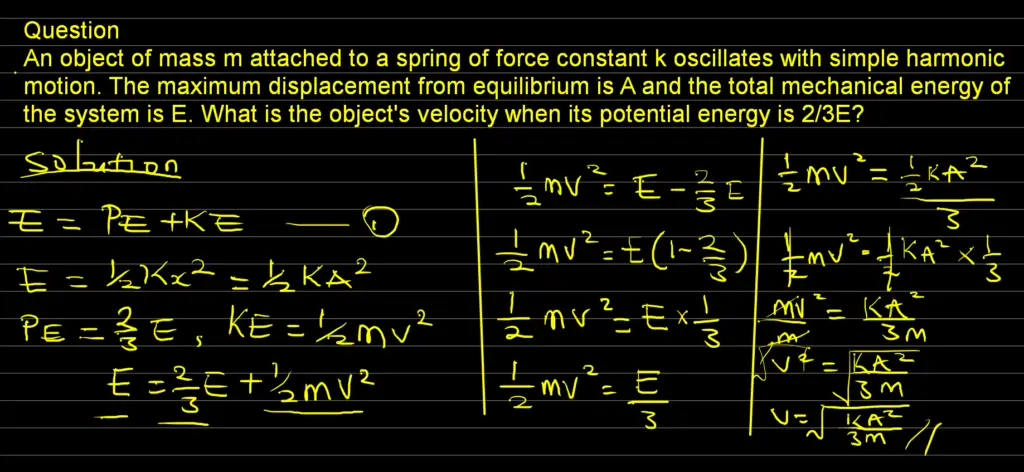Question
An object of mass m attached to a spring of force constant k oscillates with simple harmonic motion. The maximum displacement from equilibrium is A and the total mechanical energy of the system is E. What is the object’s velocity when its potential energy is 2/3E?
Video Explanation
Looking for where to Promote Your Online Course?
Join Learnworlds: The best online course platform for creating, and promoting your online courses.
Image Explanation
Below is a picture solution of the above question:

Text Explanation
Data
Revealed values from the question
Mass of the object = m
Spring Constant = k
Maximum displacement of the spring, x = A
Mechanical Energy of the system, M.E = E
Potential energy, P.E = 2/3E
Unrevealed Value from the question:
The velocity of the object = v
Important Formulae to use:
Mechanical energy is given by M.E = Potential Energy (P.E) + Kinetic Energy (K.E)
And the potential energy of an elastic spring is P.E = (1/2)kx2 = (1/2)kA2 [Because x = A from the question]
The kinetic energy of the spring is given by K.E = (1/2)mv2
E = P.E = (1/2)kA2
Check Questions and Answers on any topic here:
The biggest database of Questions & Answers is available for you! Sign Up Now!
Solution
We will now apply our data and formulae to solve the problem
Since M.A = P.E + K.E
We can equally insert our data into the above formula for the mechanical energy of the system
E = 2/3E + (1/2)mv2
We will now make v subject of the formula
(1/2)mv2 = E – 2/3E
solving the right-hand side we will subtract 2/3E from E and obtain
(1/2)mv2 = E (1 – 2/3)
to get
(1/2)mv2 = (1/3)E
But E = (1/2)kA2 and this implies that the above equation is
(1/2)mv2 = (1/3)(1/2)kA2
from the above equation, 1/2 will cancel each other on both hands leaving us with
mv2 = (1/3)kA2
We can now divide both sides by m to get
v2 = (1/3m)kA2
We can now take the square-root of both sides to make v subject of the formula
v = √(kA2/3m)
Hence the answer to what is the object’s velocity when its potential energy is 23e? is v = √(kA2/3m)
You may also like to read:
The amplitude of a lightly damped oscillator decreases by 3.0% during each cycle.
How to Calculate Kinetic Energy
How to Calculate Work Done in Physics